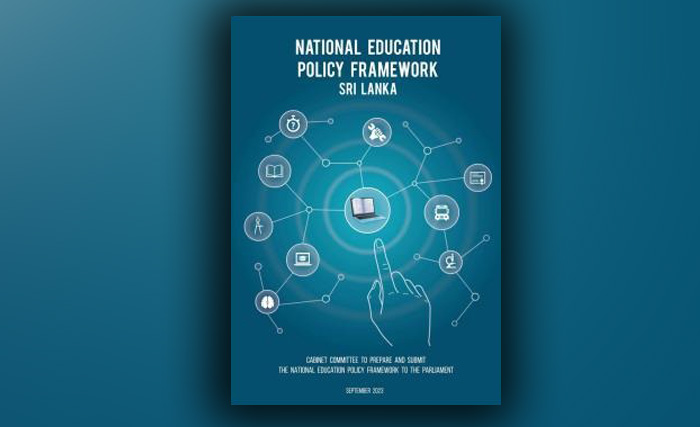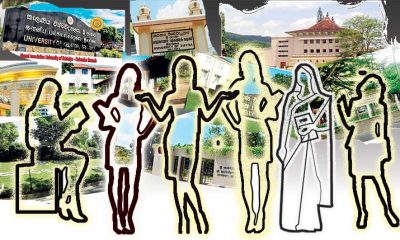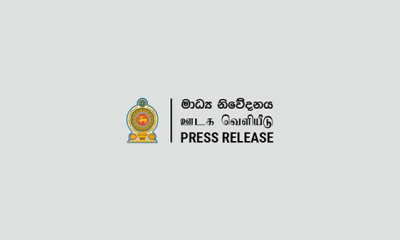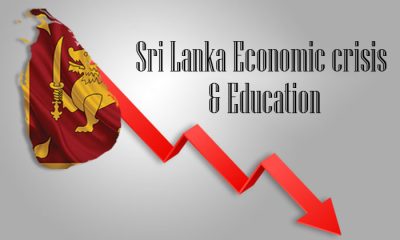Features
Education reform or hidden agenda? Scrutinising proposed NEPF

by Nalaka Samaraweera
The new National Education Policy Framework (NEPF) was prepared by a Cabinet committee chaired by the President and assisted by a Cabinet-appointed committee of experts. Having been submitted to the Parliamentary Sectoral Oversight Committee (SOC) on Education, it is already in the implementation phase following the SOC’s recommendations. Unfortunately, public debate and dialogue generated regarding such an important and impactful set of policy proposals has been entirely inadequate. Therefore, this article is written with the intention to stimulate such discussion.
Before even considering the content of the new NEPF, several questions arise about its necessity, given the existence of a comprehensive National Education Policy Framework prepared by the National Education Commission (NEC) for 2020-2030. The new NEPF covers 2023-2033. Why was a new policy framework needed after just three years? This question remains unanswered, and the new NEPF does not have references the NEC report.
Based on the preface, one might speculate that the new conditions brought about by the Covid pandemic and economic downturn since 2020 necessitated the new framework. It would have been more practical and appropriate to ask the NEC to amend their report or create a new one rather than appointing entirely a new committee. The policy framework appears to be a highly misleading document, contradicting the rationale mentioned in the preface and further challenging the country’s Constitution.
The framers of the NEPF focused on three policy domains, namely Teaching, Learning and Credentialing; Governance; and Investments and Resources. This article presents a critique of policy proposals related to “Governance.” The NEPF defines “Governance” as:
“Governance
Actors and institutions with a stake in the Sector, both state and non-state, shall be identified and their roles and functions clearly defined allowing for autonomy based on the principle of subsidiarity, ensuring alignment with national standards to minimize top-down decision-making and avoid institutions acting in silos.”
The heavy lifting in this definition is done by the less publicly known term: The Principle of Subsidiarity. According to the author’s knowledge, one of the initial appearances of this principle in Sri Lanka’s Constitutional history is found in the Centre-Periphery Sub-Committee Report, prepared by a committee, chaired by D. Sithadthan, MP. It was submitted to the Constitutional assembly, which was established to draft a new Constitution by the then “Yahapalana” government. The report defines the principle of subsidiarity as follows:
“This suggestion was based on the principle of subsidiarity, i.e., whatever the lowest level of governing institution can handle should be left with that body or unit, and the rest should go to the next tier, and so on. This notion is contrary to the present model of transferring political power from the centre to sub-national units.” (
The emphasis is by the author). It goes without saying that the recommendation of this principle violates the current unitary structure of the country. The process of drafting a new Constitution had to be halted due to significant criticism and the lack of the support of the public on this matter. Years after this infamous attempt, how could such a principle that goes against the unitary structure of the country find its way into an education policy framework? The conclusion that the framers of this policy are fully aware of the implications of this principle and intend to weaken the central government is reinforced by the following policy proposals that appears in the NEPF:
7.4 Provincial Boards of Education shall be established in the each of the nine Provinces, with autonomy within national standards to ensure education policies and practices are tailored to the specific needs and circumstances of different provinces. The Provincial Boards of Education may establish new colleges and universities in accordance with national standards.
However, as made very clear under Appendix III Education (9) of the Constitution, Provincial Boards of Education are entrusted with the advisory functions. For the reader’s convenience, the section as it appears is quoted below.
9. Appointment of Provincial Boards of Education which will have the advisory functions, will be the responsibility of the Minister of Education. However, this will be done with the concurrence of the Chief Minister of the Provincial Authority.
The reader will agree that it is quite a serious matter when a “committee of experts” presumes to bestow powers exceeding those assigned Constitutionally upon the Provincial Boards of Education. It is important to remember that the central government’s establishment above all residual state structures is a fundamental character of a unitary state. The decentralization of self-governing powers is not authorized in any way by the Constitution of Sri Lanka.
Higher education and the establishment of higher education institutions are functions listed in the Concurrent List, as introduced by the 13th Amendment, of the Constitution, thereby delegating these powers to both the central and provincial governments. Strikingly, the proposed policy framework suggests removing these powers from the central government and transferring solely to the provincial governments. Furthermore, it proposes enacting laws to convert existing universities into provincial universities. This is mentioned in paragraph 7.8, as partially quoted below.
“Establishment of new universities shall be done under the Provincial Councils. Existing degree awarding institutes shall become Provincial Universities under a new law.“
The power to establish higher education institutions, defined as a concurrent task in the Constitution, be redefined as a responsibility solely for provincial councils? This, in popular political terms, goes beyond the provisions of the 13th amendment, suggesting “13+.” Below are the roles listed in the Concurrent List for Higher Education in the Constitution.
4. Higher Education –
4:1 The establishment and maintenance of new Universities.
4:2 The establishment of degree awarding institutions under the Universities (Amendment) Act, No. 07 of 1985 and other institutions for tertiary, technical and post-school education and training.
The Indian Constitution also included education as a concurrent function through the 42nd amendment. A key argument for moving education from the state list to the concurrent list is that education, particularly higher education, should be regarded as a matter of national importance. The intent is to ensure that regionalism does not become a primary factor. However, the new policy proposes to confine higher education to regionalism, which is a regressive step.
No less serious is the proposal given in 7.10.
7.10 All Education Providers shall have autonomy within the guidelines set by the national and Provincial Authorities, and School Boards where relevant, in administration, finance, human resource management and selection of students.
Why should education providers be granted autonomy? What exactly is meant by self-governing powers regarding student selection? This assertion poses a significant risk. There’s a danger of breaching the established procedure for university student recruitment, which has been upheld irrespective of ethnic, religious, and social status differences.
Now let us shift our attention to the establishment of the new National Higher Education Commission, proposed in paragraph 7.8. This fresh entity is to replace current University Grants Commission (UGC), and its role will be defined as follows:
7.8 National Higher Education Commission (NHEC) will replace the University Grants Commission and shall be responsible for the coordination of higher education adhering to national policies and maintenance of academic standards in all degree and degree equivalent credentials issued by Higher Educational Institutions, whether State, Non-State, National and Provincial.
We urge the entire university community, academics, administrators, and students, to closely examine this proposal, as several significant issues arise with this proposed replacement. Firstly, the purpose of the new institution needs clarification. If the problem is that the current UGC lacks adequate power or does not play a sufficient role, it could be easily remedied. Why does it needed to abolish the entire institution? The role of the existing UGC is broad. For example, the University Grants Commission has a crucial role to play in planning and coordinating university education, fixing the finances of higher education institutions and regulating the administration of these institutions, maintaining academic standards, and regulating the admission of students to higher education institutions. It appears that the new institution proposed to be established is focused only on maintaining standards in accordance with national policies.
Should this new institution be relieved of such extensive responsibilities, who will assume other tasks conducted by the UGC? Will they be entrusted to the local bodies proposed to receive autonomous powers mentioned earlier? Surely it will be disastrous for the universities. Consider, for instance, the allocation of funds to universities. As the new policy framework suggests, it will be the role of provincial governments to allocate money to universities. But it is a well-known fact that the local government bodies basically run their activities with the money they get from the central government. In such a situation, can it be ensured that sufficient funds will be allocated to the universities? What attitudes will different provincial councils have regarding universities? How much irregularity and inefficiency can occur in giving central government money indirectly to universities through provincial governments? How do the attitudes and priorities of provincial council politicians affect universities? In short, how do the academics deal with local political dynamics?
Acting as an intermediary buffer body between the Ministry of Education and the universities, the UGC has thus far upheld the honorable responsibility of safeguarding university independence from direct political interference. Our regional countries such as India, Pakistan, and Bangladesh also run institutions similar to the model of the UGC for this purpose.
Moreover, when studying the history of Sri Lankan universities, it appears that the establishment of the UGC by the University Act of 1978 was a progressive step that ensured the relative independence of the university compared to the previous body, National Council of Higher Education. Does this new policy framework propose to reverse the forward steps we took? Given the manner in which this proposal is presented, it is reasonable to entertain such suspicions.
What is surprising, or perhaps not, is the absence of any mention of university autonomy in this new policy framework. Instead, there are multiple references to granting autonomy to provincial institutions. Why have these policymakers treated this matter so lightly? National Education Commission’s Education Policy Framework (2020-2030) previously presented, adopted a very positive stance on university autonomy and proposed measures to strengthen it. How do we reconcile this framework’s complete disregard for that stance? Lastly, it must be emphasized that if this new policy framework is fully implemented, we will face grave consequences. Despite any progress we may have made in education thus far, there is a risk of regression. It is also disheartening to note the lack of professionalism exhibited by the compilers this new framework. We hope our readers grasp the true intentions behind this new policy framework.
(The writer is a Senior Lecturer at the Faculty of Engineering, University of Moratuwa. Views expressed in the article are personal.)
Features
The heart-friendly health minister

by Dr Gotabhya Ranasinghe
Senior Consultant Cardiologist
National Hospital Sri Lanka
When we sought a meeting with Hon Dr. Ramesh Pathirana, Minister of Health, he graciously cleared his busy schedule to accommodate us. Renowned for his attentive listening and deep understanding, Minister Pathirana is dedicated to advancing the health sector. His openness and transparency exemplify the qualities of an exemplary politician and minister.
Dr. Palitha Mahipala, the current Health Secretary, demonstrates both commendable enthusiasm and unwavering support. This combination of attributes makes him a highly compatible colleague for the esteemed Minister of Health.
Our discussion centered on a project that has been in the works for the past 30 years, one that no other minister had managed to advance.
Minister Pathirana, however, recognized the project’s significance and its potential to revolutionize care for heart patients.
The project involves the construction of a state-of-the-art facility at the premises of the National Hospital Colombo. The project’s location within the premises of the National Hospital underscores its importance and relevance to the healthcare infrastructure of the nation.
This facility will include a cardiology building and a tertiary care center, equipped with the latest technology to handle and treat all types of heart-related conditions and surgeries.
Securing funding was a major milestone for this initiative. Minister Pathirana successfully obtained approval for a $40 billion loan from the Asian Development Bank. With the funding in place, the foundation stone is scheduled to be laid in September this year, and construction will begin in January 2025.
This project guarantees a consistent and uninterrupted supply of stents and related medications for heart patients. As a result, patients will have timely access to essential medical supplies during their treatment and recovery. By securing these critical resources, the project aims to enhance patient outcomes, minimize treatment delays, and maintain the highest standards of cardiac care.
Upon its fruition, this monumental building will serve as a beacon of hope and healing, symbolizing the unwavering dedication to improving patient outcomes and fostering a healthier society.We anticipate a future marked by significant progress and positive outcomes in Sri Lanka’s cardiovascular treatment landscape within the foreseeable timeframe.
Features
A LOVING TRIBUTE TO JESUIT FR. ALOYSIUS PIERIS ON HIS 90th BIRTHDAY

by Fr. Emmanuel Fernando, OMI
Jesuit Fr. Aloysius Pieris (affectionately called Fr. Aloy) celebrated his 90th birthday on April 9, 2024 and I, as the editor of our Oblate Journal, THE MISSIONARY OBLATE had gone to press by that time. Immediately I decided to publish an article, appreciating the untiring selfless services he continues to offer for inter-Faith dialogue, the renewal of the Catholic Church, his concern for the poor and the suffering Sri Lankan masses and to me, the present writer.
It was in 1988, when I was appointed Director of the Oblate Scholastics at Ampitiya by the then Oblate Provincial Fr. Anselm Silva, that I came to know Fr. Aloy more closely. Knowing well his expertise in matters spiritual, theological, Indological and pastoral, and with the collaborative spirit of my companion-formators, our Oblate Scholastics were sent to Tulana, the Research and Encounter Centre, Kelaniya, of which he is the Founder-Director, for ‘exposure-programmes’ on matters spiritual, biblical, theological and pastoral. Some of these dimensions according to my view and that of my companion-formators, were not available at the National Seminary, Ampitiya.
Ever since that time, our Oblate formators/ accompaniers at the Oblate Scholasticate, Ampitiya , have continued to send our Oblate Scholastics to Tulana Centre for deepening their insights and convictions regarding matters needed to serve the people in today’s context. Fr. Aloy also had tried very enthusiastically with the Oblate team headed by Frs. Oswald Firth and Clement Waidyasekara to begin a Theologate, directed by the Religious Congregations in Sri Lanka, for the contextual formation/ accompaniment of their members. It should very well be a desired goal of the Leaders / Provincials of the Religious Congregations.
Besides being a formator/accompanier at the Oblate Scholasticate, I was entrusted also with the task of editing and publishing our Oblate journal, ‘The Missionary Oblate’. To maintain the quality of the journal I continue to depend on Fr. Aloy for his thought-provoking and stimulating articles on Biblical Spirituality, Biblical Theology and Ecclesiology. I am very grateful to him for his generous assistance. Of late, his writings on renewal of the Church, initiated by Pope St. John XX111 and continued by Pope Francis through the Synodal path, published in our Oblate journal, enable our readers to focus their attention also on the needed renewal in the Catholic Church in Sri Lanka. Fr. Aloy appreciated very much the Synodal path adopted by the Jesuit Pope Francis for the renewal of the Church, rooted very much on prayerful discernment. In my Religious and presbyteral life, Fr.Aloy continues to be my spiritual animator / guide and ongoing formator / acccompanier.
Fr. Aloysius Pieris, BA Hons (Lond), LPh (SHC, India), STL (PFT, Naples), PhD (SLU/VC), ThD (Tilburg), D.Ltt (KU), has been one of the eminent Asian theologians well recognized internationally and one who has lectured and held visiting chairs in many universities both in the West and in the East. Many members of Religious Congregations from Asian countries have benefited from his lectures and guidance in the East Asian Pastoral Institute (EAPI) in Manila, Philippines. He had been a Theologian consulted by the Federation of Asian Bishops’ Conferences for many years. During his professorship at the Gregorian University in Rome, he was called to be a member of a special group of advisers on other religions consulted by Pope Paul VI.
Fr. Aloy is the author of more than 30 books and well over 500 Research Papers. Some of his books and articles have been translated and published in several countries. Among those books, one can find the following: 1) The Genesis of an Asian Theology of Liberation (An Autobiographical Excursus on the Art of Theologising in Asia, 2) An Asian Theology of Liberation, 3) Providential Timeliness of Vatican 11 (a long-overdue halt to a scandalous millennium, 4) Give Vatican 11 a chance, 5) Leadership in the Church, 6) Relishing our faith in working for justice (Themes for study and discussion), 7) A Message meant mainly, not exclusively for Jesuits (Background information necessary for helping Francis renew the Church), 8) Lent in Lanka (Reflections and Resolutions, 9) Love meets wisdom (A Christian Experience of Buddhism, 10) Fire and Water 11) God’s Reign for God’s poor, 12) Our Unhiddden Agenda (How we Jesuits work, pray and form our men). He is also the Editor of two journals, Vagdevi, Journal of Religious Reflection and Dialogue, New Series.
Fr. Aloy has a BA in Pali and Sanskrit from the University of London and a Ph.D in Buddhist Philosophy from the University of Sri Lankan, Vidyodaya Campus. On Nov. 23, 2019, he was awarded the prestigious honorary Doctorate of Literature (D.Litt) by the Chancellor of the University of Kelaniya, the Most Venerable Welamitiyawe Dharmakirthi Sri Kusala Dhamma Thera.
Fr. Aloy continues to be a promoter of Gospel values and virtues. Justice as a constitutive dimension of love and social concern for the downtrodden masses are very much noted in his life and work. He had very much appreciated the commitment of the late Fr. Joseph (Joe) Fernando, the National Director of the Social and Economic Centre (SEDEC) for the poor.
In Sri Lanka, a few religious Congregations – the Good Shepherd Sisters, the Christian Brothers, the Marist Brothers and the Oblates – have invited him to animate their members especially during their Provincial Congresses, Chapters and International Conferences. The mainline Christian Churches also have sought his advice and followed his seminars. I, for one, regret very much, that the Sri Lankan authorities of the Catholic Church –today’s Hierarchy—- have not sought Fr.
Aloy’s expertise for the renewal of the Catholic Church in Sri Lanka and thus have not benefited from the immense store of wisdom and insight that he can offer to our local Church while the Sri Lankan bishops who governed the Catholic church in the immediate aftermath of the Second Vatican Council (Edmund Fernando OMI, Anthony de Saram, Leo Nanayakkara OSB, Frank Marcus Fernando, Paul Perera,) visited him and consulted him on many matters. Among the Tamil Bishops, Bishop Rayappu Joseph was keeping close contact with him and Bishop J. Deogupillai hosted him and his team visiting him after the horrible Black July massacre of Tamils.
Features
A fairy tale, success or debacle

Sri Lanka-Singapore Free Trade Agreement
By Gomi Senadhira
senadhiragomi@gmail.com
“You might tell fairy tales, but the progress of a country cannot be achieved through such narratives. A country cannot be developed by making false promises. The country moved backward because of the electoral promises made by political parties throughout time. We have witnessed that the ultimate result of this is the country becoming bankrupt. Unfortunately, many segments of the population have not come to realize this yet.” – President Ranil Wickremesinghe, 2024 Budget speech
Any Sri Lankan would agree with the above words of President Wickremesinghe on the false promises our politicians and officials make and the fairy tales they narrate which bankrupted this country. So, to understand this, let’s look at one such fairy tale with lots of false promises; Ranil Wickremesinghe’s greatest achievement in the area of international trade and investment promotion during the Yahapalana period, Sri Lanka-Singapore Free Trade Agreement (SLSFTA).
It is appropriate and timely to do it now as Finance Minister Wickremesinghe has just presented to parliament a bill on the National Policy on Economic Transformation which includes the establishment of an Office for International Trade and the Sri Lanka Institute of Economics and International Trade.
Was SLSFTA a “Cleverly negotiated Free Trade Agreement” as stated by the (former) Minister of Development Strategies and International Trade Malik Samarawickrama during the Parliamentary Debate on the SLSFTA in July 2018, or a colossal blunder covered up with lies, false promises, and fairy tales? After SLSFTA was signed there were a number of fairy tales published on this agreement by the Ministry of Development Strategies and International, Institute of Policy Studies, and others.
However, for this article, I would like to limit my comments to the speech by Minister Samarawickrama during the Parliamentary Debate, and the two most important areas in the agreement which were covered up with lies, fairy tales, and false promises, namely: revenue loss for Sri Lanka and Investment from Singapore. On the other important area, “Waste products dumping” I do not want to comment here as I have written extensively on the issue.
1. The revenue loss
During the Parliamentary Debate in July 2018, Minister Samarawickrama stated “…. let me reiterate that this FTA with Singapore has been very cleverly negotiated by us…. The liberalisation programme under this FTA has been carefully designed to have the least impact on domestic industry and revenue collection. We have included all revenue sensitive items in the negative list of items which will not be subject to removal of tariff. Therefore, 97.8% revenue from Customs duty is protected. Our tariff liberalisation will take place over a period of 12-15 years! In fact, the revenue earned through tariffs on goods imported from Singapore last year was Rs. 35 billion.
The revenue loss for over the next 15 years due to the FTA is only Rs. 733 million– which when annualised, on average, is just Rs. 51 million. That is just 0.14% per year! So anyone who claims the Singapore FTA causes revenue loss to the Government cannot do basic arithmetic! Mr. Speaker, in conclusion, I call on my fellow members of this House – don’t mislead the public with baseless criticism that is not grounded in facts. Don’t look at petty politics and use these issues for your own political survival.”
I was surprised to read the minister’s speech because an article published in January 2018 in “The Straits Times“, based on information released by the Singaporean Negotiators stated, “…. With the FTA, tariff savings for Singapore exports are estimated to hit $10 million annually“.
As the annual tariff savings (that is the revenue loss for Sri Lanka) calculated by the Singaporean Negotiators, Singaporean $ 10 million (Sri Lankan rupees 1,200 million in 2018) was way above the rupees’ 733 million revenue loss for 15 years estimated by the Sri Lankan negotiators, it was clear to any observer that one of the parties to the agreement had not done the basic arithmetic!
Six years later, according to a report published by “The Morning” newspaper, speaking at the Committee on Public Finance (COPF) on 7th May 2024, Mr Samarawickrama’s chief trade negotiator K.J. Weerasinghehad had admitted “…. that forecasted revenue loss for the Government of Sri Lanka through the Singapore FTA is Rs. 450 million in 2023 and Rs. 1.3 billion in 2024.”
If these numbers are correct, as tariff liberalisation under the SLSFTA has just started, we will pass Rs 2 billion very soon. Then, the question is how Sri Lanka’s trade negotiators made such a colossal blunder. Didn’t they do their basic arithmetic? If they didn’t know how to do basic arithmetic they should have at least done their basic readings. For example, the headline of the article published in The Straits Times in January 2018 was “Singapore, Sri Lanka sign FTA, annual savings of $10m expected”.
Anyway, as Sri Lanka’s chief negotiator reiterated at the COPF meeting that “…. since 99% of the tariffs in Singapore have zero rates of duty, Sri Lanka has agreed on 80% tariff liberalisation over a period of 15 years while expecting Singapore investments to address the imbalance in trade,” let’s turn towards investment.
Investment from Singapore
In July 2018, speaking during the Parliamentary Debate on the FTA this is what Minister Malik Samarawickrama stated on investment from Singapore, “Already, thanks to this FTA, in just the past two-and-a-half months since the agreement came into effect we have received a proposal from Singapore for investment amounting to $ 14.8 billion in an oil refinery for export of petroleum products. In addition, we have proposals for a steel manufacturing plant for exports ($ 1 billion investment), flour milling plant ($ 50 million), sugar refinery ($ 200 million). This adds up to more than $ 16.05 billion in the pipeline on these projects alone.
And all of these projects will create thousands of more jobs for our people. In principle approval has already been granted by the BOI and the investors are awaiting the release of land the environmental approvals to commence the project.
I request the Opposition and those with vested interests to change their narrow-minded thinking and join us to develop our country. We must always look at what is best for the whole community, not just the few who may oppose. We owe it to our people to courageously take decisions that will change their lives for the better.”
According to the media report I quoted earlier, speaking at the Committee on Public Finance (COPF) Chief Negotiator Weerasinghe has admitted that Sri Lanka was not happy with overall Singapore investments that have come in the past few years in return for the trade liberalisation under the Singapore-Sri Lanka Free Trade Agreement. He has added that between 2021 and 2023 the total investment from Singapore had been around $162 million!
What happened to those projects worth $16 billion negotiated, thanks to the SLSFTA, in just the two-and-a-half months after the agreement came into effect and approved by the BOI? I do not know about the steel manufacturing plant for exports ($ 1 billion investment), flour milling plant ($ 50 million) and sugar refinery ($ 200 million).
However, story of the multibillion-dollar investment in the Petroleum Refinery unfolded in a manner that would qualify it as the best fairy tale with false promises presented by our politicians and the officials, prior to 2019 elections.
Though many Sri Lankans got to know, through the media which repeatedly highlighted a plethora of issues surrounding the project and the questionable credentials of the Singaporean investor, the construction work on the Mirrijiwela Oil Refinery along with the cement factory began on the24th of March 2019 with a bang and Minister Ranil Wickremesinghe and his ministers along with the foreign and local dignitaries laid the foundation stones.
That was few months before the 2019 Presidential elections. Inaugurating the construction work Prime Minister Ranil Wickremesinghe said the projects will create thousands of job opportunities in the area and surrounding districts.
The oil refinery, which was to be built over 200 acres of land, with the capacity to refine 200,000 barrels of crude oil per day, was to generate US$7 billion of exports and create 1,500 direct and 3,000 indirect jobs. The construction of the refinery was to be completed in 44 months. Four years later, in August 2023 the Cabinet of Ministers approved the proposal presented by President Ranil Wickremesinghe to cancel the agreement with the investors of the refinery as the project has not been implemented! Can they explain to the country how much money was wasted to produce that fairy tale?
It is obvious that the President, ministers, and officials had made huge blunders and had deliberately misled the public and the parliament on the revenue loss and potential investment from SLSFTA with fairy tales and false promises.
As the president himself said, a country cannot be developed by making false promises or with fairy tales and these false promises and fairy tales had bankrupted the country. “Unfortunately, many segments of the population have not come to realize this yet”.
(The writer, a specialist and an activist on trade and development issues . )
























